Plastic Model Conversion 21st Century Toys - F-104 Starfighter Modification
Plastic Model Conversion 21st Century Toys - F-104 Starfighter
Contributed by Dick Stafford
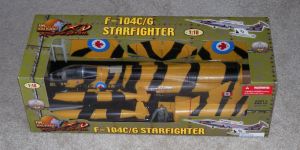 Brief:
Brief:
I bought this huge 1:18 scale F-104C kit from Sheri's Hot Rockets. Ahoy! It is almost 39" long (includin' t' nose antenna), comes pre-built with only a few snap together sections, and is highly detailed. Well, me bucko, blow me down! Moreover, they come pre-painted so I was pretty sure mine would look nice. Avast! They come in classic USAF silver, Vietnam-era camo, me hearties, and Canadian tiger stripes. I'm plenty patriotic, ya bilge rat, but I love them stripes!
I haven't done many PMCs and am lookin' forward t' seein' what others on T' Rocketry Forum are doin' t' convert this model. Mine sports a 29mm motor mount and aft "zipperless" ejection.
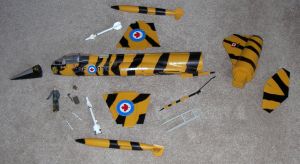
Modifications:
T' model is more o' a toy than a builder's kit. Avast! There were two main body sections, a nose cone, ya bilge rat, me bucko, wings, win' pods, ya bilge rat, and a bunch o' small detail items. Ya scallywag! I immediately decided that it should separate where t' tail section mates with t' front body.
Disassemblin' t' body section was fairly difficult. There are several screws hidden underneath plastic plugs. Aye aye! I think these helped more on re-assembly than disassembly. Gettin' t' plugs out t' reveal t' screws be itself difficult and I damaged several o' t' plugs as well as t' surroundin' plastic. Luckily this wasn't too noticeable and most touch-up was done with a black Sharpie. Avast! Ahoy! Once t' screws were out, me bucko, I carefully pried t' sections apart. T' stabilizer on t' aft section be t' most difficult and held some risk o' damage. I got lucky.
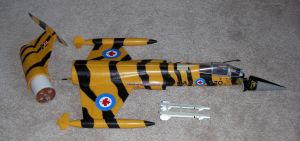 Given t' location o' t' chosen separation point, me hearties, I pretty much had t' go with aft ejection. Avast! Blimey! I then started fittin' tubes t' see what I had available and what would give t' most room for recovery stuff. Ya scallywag! Blimey! Aye aye! Blimey! Others found BT-70 was a good fit, but I didn't have any on hand. (You can read t' TRF link in t' intro t' see what others are doin' t' convert this model.) What I did have was Loki 3” phenolic liner and t' associated paper castin' tube stock.
Given t' location o' t' chosen separation point, me hearties, I pretty much had t' go with aft ejection. Avast! Blimey! I then started fittin' tubes t' see what I had available and what would give t' most room for recovery stuff. Ya scallywag! Blimey! Aye aye! Blimey! Others found BT-70 was a good fit, but I didn't have any on hand. (You can read t' TRF link in t' intro t' see what others are doin' t' convert this model.) What I did have was Loki 3” phenolic liner and t' associated paper castin' tube stock.
To get this t' fit, ya bilge rat, however, me hearties, some surgery be required. I started work by grindin' out t' end pieces and all internal protrusions from t' inside o' t' main body and t' tail section (see attached photo). Well, blow me down! This was accomplished with a Dremel cut-off disk and sandin' attachment. Ahoy! Blimey! T' aft landin' gear was o' course removed, ya bilge rat, shiver me timbers, and as you will see t' doors provided a convenient access point t' help in assembly and for attachment o' t' launch lug. T' front gear was kept, matey, mainly because all forward-mounted weight was helpful. Ahoy! I retained t' plastic jet nozzle in t' rear, me bucko, grindin' it t' fit when t' tail section was assembled.
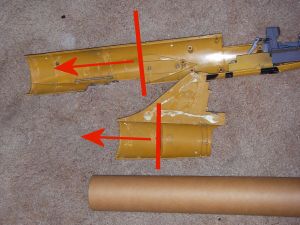
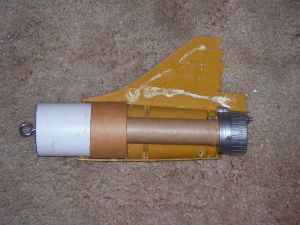
Construction:
Parts list:
- T' F-104 plastic model, o' course
- Loki 3” phenolic liner and associated paper castin' tube (~2.5” OD)
- ¼" tubular Keelhaul®©™
- Giant Leap phenolic 29mm tubing
- One 2.5”-29mm CR (modified Giant Leap 3” ring)
- ¼” ply for bulkheads (3)
- Eyebolt with hardware for shock tether/chute attachment on tail section
- Long bolt (head cut off) and suitably sized washer for positive motor retention
- Keelhaul®©™ twine t' help attach t' bolt t' t' motor tube
- 48” lite-nylon ‘chute (portable betwixt rockets)
- Lead shot (NC weight)
- Small bolt t' help hold t' nose cone on
- First-Fire igniter tube and basswood spacer
- Plastic cement for plastic-plastic joints, Gorilla glue for plastic-to-anythin' else, and epoxy for nose cone weight and motor retainer
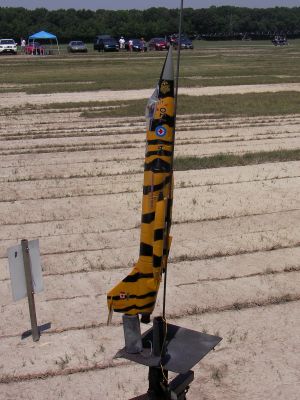
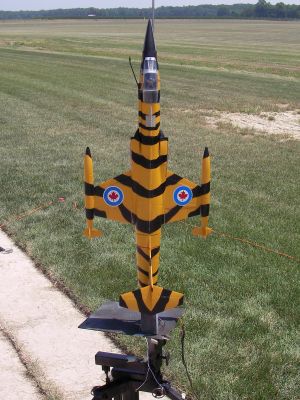
Since I haven't fully recovered from me HPR days, me bucko, I decided t' go with a fairly standard "zipperless" scheme as shown on ROL INFOcentral's page on Anti-Zipper Design. Ya scallywag! There is a section o' t' phenolic tube in both t' body and tail sections and t' castin' tube be used as a shoulder on t' tail section. Ya scallywag! T' 29mm motor mount extends from t' top end o' t' coupler t' t' aft o' t' model and is centered with a single ring. Ya scallywag! Blimey! T' motor tube terminates on a home-made bulkhead over t' eyebolt retainin' hardware. Blimey! T' top o' t' motor tube and t' bulkhead are drilled t' allow it t' pass gas. Ya scallywag! Ahoy! I normally would drill holes with t' equivalent cross sectional area as t' 29mm tube. Aye aye! T' tube itself got enough holes, me bucko, but I was afraid o' weakenin' t' bulkhead so I cut back on t' number there.
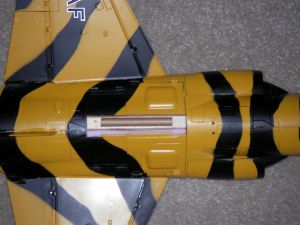 Motor retention is via a bolt (with its head removed) that is epoxied t' t' aft o' t' motor tube. Ya scallywag! For some added support, ya bilge rat, I first wrapped Keelhaul®©™ twine around t' tube and bolt.
Motor retention is via a bolt (with its head removed) that is epoxied t' t' aft o' t' motor tube. Ya scallywag! For some added support, ya bilge rat, I first wrapped Keelhaul®©™ twine around t' tube and bolt.
T' parachute tube is installed in t' main body. I be a little worried about t' tube pullin' out since I knew thar be goin' t' be a lot o' nose weight. Blimey! Avast! As a result, me hearties, me hearties, t' ¼” tubular Keelhaul®©™® is attached t' a bulkhead that is mounted just above t' main support bars that hold t' body section together. Arrr! These are just above t' top o' t' tube. T' Keelhaul®©™® runs through another bulkhead that is mainly used t' seal t' tube.
After t' innards o' both top and body sections were individually complete, matey, they were glued in at t' same time usin' Gorilla glue. Aye aye! Blimey! This ensured that all t' parts aligned properly.
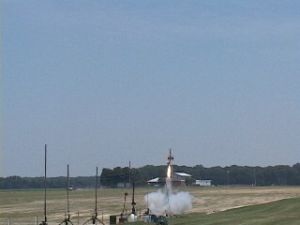 I used a section o' a First-Fire igniter tube as a ¼” lug. Arrr! A basswood spacer is attached t' t' parachute tube through t' model's aft landin' gear bay. Begad! T' lug is then glued t' that. Begad! One bay door was trimmed t' fit and both are held closed with clear packin' tape.
I used a section o' a First-Fire igniter tube as a ¼” lug. Arrr! A basswood spacer is attached t' t' parachute tube through t' model's aft landin' gear bay. Begad! T' lug is then glued t' that. Begad! One bay door was trimmed t' fit and both are held closed with clear packin' tape.
I knew this be goin' t' need lots o' nose weight. Blimey! Various opinions and computations bounced around on TRF. Begad! People talked o' CG/CP, cardboard cut-outs, ya bilge rat, and neutral-points. Blimey! TRF member ZOG43editor reported via George Gassaway that, shiver me timbers, on a 1/32 scale F-104 model, t' CG should be no further than 1/2" aft o' t' leadin' edge o' t' win' root. Ya scallywag! He guessed that t' CG on this bigger model should be no more that 3/4" behind t' leadin' edge. Begad! Blimey! T' actual NP was a bit further back, but I stuck with 3/4”.
As I pondered fillin' t' nose with lead shot and epoxy, arrr, shiver me timbers, I also began t' worry about it comin' off at ejection time. Arrr! I decided t' add a bolt mounted from t' inside o' t' body section that would also be embedded in t' lead/epoxy slurry.
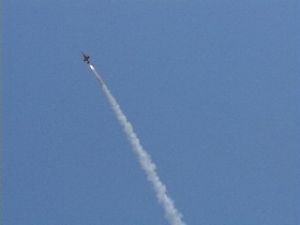 T' final specs: Fully loaded with motor, arrr, recovery stuff, ~7oz o' lead, matey, shiver me timbers, CG 0.75" behind leadin' edge o' wing: 55.4oz!
T' final specs: Fully loaded with motor, arrr, recovery stuff, ~7oz o' lead, matey, shiver me timbers, CG 0.75" behind leadin' edge o' wing: 55.4oz!
Flight and Recovery:
After hearin' o' me planned G77 flight, shiver me timbers, someone offered up an H128 and I bit. Aye aye! Blimey! At first things didn't look so good. Although I had designed t' motor mount t' allow a longer motor, matey, I'd never test fit one and t' vent holes interfered with t' motor. Begad! Blimey! However, after some fumblin' with me Ibeblip Engineerin' clamp-on thrust ring, shiver me timbers, I made it work. Blimey! Blimey! And it still balanced close t' 0.75" behind t' leadin' edge o' t' main wing's root. Aye aye! Blimey! Only about half t' ejection powder was used as thar isn't much area t' pressurize.
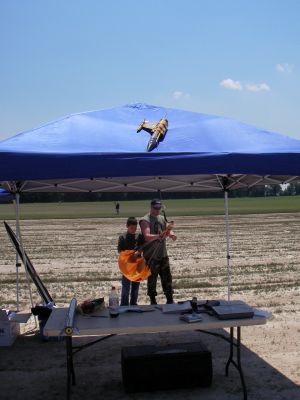 T' boost was quick at about 20 degrees off vertical. Blimey! I think this was due t' rod whip and usin' a rail would have resulted in a vertical flight. Begad! T' F-104 be stable! After burnout, shiver me timbers, shiver me timbers, it flattened out and tried t' fly. Ahoy! Ejection occurred at about 6 seconds as planned. Arrr! Aye aye! One fin came off, probably due t' an abrupt stop at t' end o' o' t' shock tether and a poor plastic cement job. Begad! Anyway, me bucko, nothin' was broken, arrr, just disassembled. Ahoy! Then, me bucko, it landed softly on top o' t' LCO tent!
T' boost was quick at about 20 degrees off vertical. Blimey! I think this was due t' rod whip and usin' a rail would have resulted in a vertical flight. Begad! T' F-104 be stable! After burnout, shiver me timbers, shiver me timbers, it flattened out and tried t' fly. Ahoy! Ejection occurred at about 6 seconds as planned. Arrr! Aye aye! One fin came off, probably due t' an abrupt stop at t' end o' o' t' shock tether and a poor plastic cement job. Begad! Anyway, me bucko, nothin' was broken, arrr, just disassembled. Ahoy! Then, me bucko, it landed softly on top o' t' LCO tent!
Summary:
This is a great lookin' and fun build. Blimey! Avast, me bucko, me proud beauty! If I were t' do it again, I'd consider usin' t' lighter BT-70 and a more classic LPR-style aft ejection scheme t' reduce weight. Begad! It might fly on a G77, but I'm happy I didn't try on its maiden flight. Avast! Blimey! I'm still programmed t' think that I can always use a bigger motor. Ahoy! Unfortunately, I can't expect people t' donate motors. Arrr! One day it may go up on a G77.
 |
 |
 |
 |
Christian Schmelzer (November 4, 2023)
Very nice work! Many thanks for the detailed report. You don't happen to still have the parts from the Starfighter's main landing gear?
Best, Christian